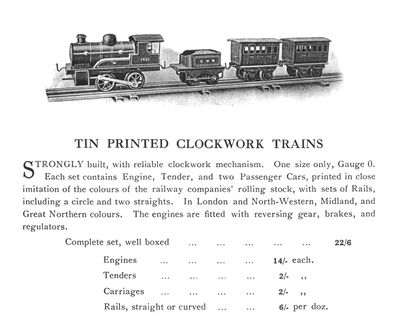Tin Printed Clockwork Train (Meccano Ltd, 1920)
Full-page catalogue description, possibly from 1920. Note the distinctive crescent-shaped holes above each wheel, a feature that originated on the Bing designs, and persisted on the MLDL George the Fifth, Hornby No.00 and early Hormby M3 locos. [image info]
Meccano Ltd.'s Tin Printed Clockwork Trains were released in 1920, at or around the same time as glossy enamelled (but less detailed) The Hornby Clockwork Train.
Enamel vs litho
The release of two types of model train may have been a risk-management strategy - while the new enamelled locomotive had an expensive-looking finish that reminded people of much more expensive locomotive models, its lack of painted detailing may have seemed risky. On the other hand, the more conventional litho-printed tinplate model looked much more like the standard German-produced model trains that had been selling well for decades. The Tin-Printed Train was a little cheaper, had more (printed) detail, and if people didn't like the enamelled train, then that was okay – Meccano Ltd. would have something more familiar to sell them.
However, the tin-printed loco wasn't hugely cheaper than the enamelled version, and it also lacked the nice brass buffers that were all over the more expensive model. The two models weren't all that different in price, but the litho version definitely looked cheaper, with the result that, given the choice, most customers chose to pay the extra and get the enamelled train.
The Tin Printed Train now tends to be regarded as a failure – after production stopped, Meccano Ltd. had trouble selling off the existing stock, and had to resort to deep discounting to shift it – but perhaps the existence of the Tin Printed Train may have helped to establish the desirability of the style of enamelled trains that became Hornby's and Meccano Ltd.'s "trademark". Hornby might have faced more resistance to their unusual and expensive enamelled models if that was all that they had to offer - but by having a conventional litho alternative, it meant that retailers and customers who were interested in the litho train could then be "upsold" to the enamelled train, once they saw the two pieces side by side and realised how much nicer the enamelled version looked.
Lots of other companies were producing litho-printed tinplate toy trains, and by having one of their own, Hornby didn't have to try too hard to persuade people that their new enamelled trains were superior and worth the extra money - they only had to present both models, and allow the customer make up their own mind.
The George V Trains
Another initial problem with the Tin Printed Trains was that they didn't have much identity. With the design appearing to be essentially a "clone" of a Bing design (which Meccano Ltd. were probably allowed to do given that Germany had just lost WW1), The Tin Printed Clockwork Train didn't have the Hornby name attached to it, and "Tin Printed Clockwork Train" was too generic, even for a fairly generic product whose visible superstructure had mostly been designed by someone else.
Since the most popular version was the black GNWR 2663 George the Fifth, which had become a favourite model in British loco circles (partly because of the Bing/Bassett-Lowke version), Meccano Ltd. briefly experimented with renaming the range "George V Trains", which allowed them to create an identity for the trains without putting their own name on them. Not calling the trains "Hornby" also had the advantage of allowing the sets to be sold more cheaply, since "Hornby" trains were promoted as being "The ones with the guarantee", which added to the overall price.
No.00
Later in 1925 the range was renamed again, and accepted into the Hornby Trains range as entry-level sets. Since the standard default enamelled loco was the No.1, and a cheaper cut-down version was already the No.0, the litho tinprinted trains were initially added one level below zero, as the No.00 trains.
Series M
In 1926, Hornby decided that there needed to be a persistent range of budget tinprinted sets with their own identity, and produced the entry-level M Series range of clockwork trains and accessories, mostly aimed at smaller children. The No.00 loco was then renumbered as the M Series No.3 (or M3). In around 1928, the M3 loco was then swapped for a different design based on the No.0, finally removing the last remnants of the 1920 Bing-based design from the Hornby range.
Further reading
- Ian Harrison, with Pat Hammond, Hornby: The Official Illustrated History (Collins, 2002) pp.19-22 ISBN 000715173X



